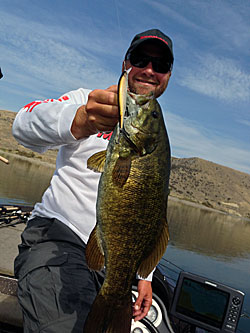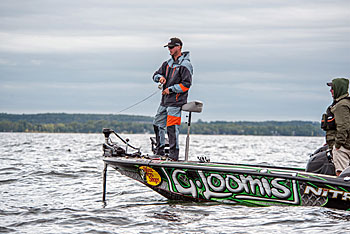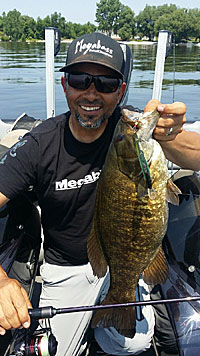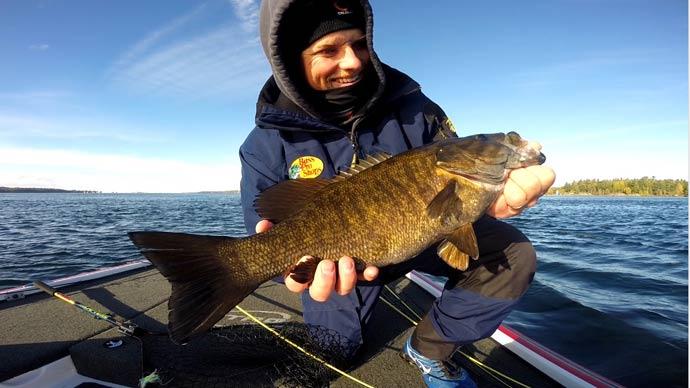
In part one of this article, we looked at how early fall smallmouth relates to shallower water. Bassmaster Elite pros Luke Clausen and Jonathon VanDam and top Canadian stick, Nick Cousvis, are back at it for part two. They’ll weigh in on where smallmouth will stage before heading to their winter haunts and the best way to catch them once water temps consistently dip well below 60 degrees.
Mid-Range Smallmouth
Luke Clausen, who will be fishing the Bassmaster Elite Series in 2016, the last weeks of August and the beginning of September, can provide an excellent topwater bite. He’ll comb the same productive summer areas trying to ring the dinner bell one more time. Clausen will seek out shallow aggressive smallmouth with a Megabass Giant Dog X in the GG Perch pattern, either first thing in the morning or just before dinner. He will also have a jerkbait tied on. On some bodies of water, Clausen’s noticed that the bigger fish are the last ones to leave the shallow, water-usually the first week of October. “You might only catch eight or nine fish a day, but they’ll be better than average,” Clausen said.
He rolls up his sleeves and gets ready to break a sweat casting crankbaits around deep vegetation. Of particular interest are areas that have cabbage weed in 20 feet of water but only grow 8 feet off the bottom. “Many people hit bottom when they’re cranking, like for largemouth, but I fish over them,” Clausen started.
“I always want my crankbait to be several feet above the fish. If I’m fishing 15 feet of water, I have no problem throwing a bait that dives eight feet, and I’ll work it the same way I do a spinnerbait.” His favorite crankbait is a Megabass Deep-X 150 in PM Setsuki Ayu and GG Perch. He fishes on a Megabass Orochi XX Flat-Side Special rod and 12-pound Gamma Edge fluorocarbon. He swaps out the hooks from the factory and adds #4 hooks with the biggest barbs he can find so those smallmouths cannot easily come unbuttoned. Clausen believes too much fuss is made about the colors of crankbaits. The rate of retrieve is far more critical when triggering bites.
Jonathon VanDam keys in on points that have real sharp drop-offs on or nearby them. “You fish where it starts to flatten out near the bottom or on its top,” VanDam said. “They’ll either be there or on those breaks where those flats taper off, and they meet a deep break that’s reel sharp, and they’ll be on the top of that.”
VanDam quickly pointed out that it’s equally important to finding fish to find the bait. He uses down imaging when running his Humminbird 1199 units because the view provides not only the best way to read bait, but he can distinguish the fish feeding within the schools. Come fall, smallmouth are notorious for hugging the bottom, making it hard to distinguish between them and 2D sonar. With down imaging, the differentiation between them is unmistakable, and an angler can decipher whether they see a rock on the bottom or whether it is a fish with its belly to the ground. When VanDam needs to key in on edges holding bait, his 360 imaging shines as it deciphers the contours and transitions in front of him. He’ll target similar deep-water areas throughout the year.
Fall can be tricky, especially when smallmouth move from summer to winter haunts. Many Elite pros who fished the AOY tournament at Sturgeon Bay struggled to pin down the mood or nomadic ways of a population of smallmouth who generally didn’t want to be found or bothered with.
“At Sturgeon Bay, they’d bite the first couple hours, then you’d get a bite an hour, and then between 1 p.m. and 3 p.m., you’d start marking fish again, and they’d start feeding again,” VanDam said. Smallmouth are anything but predictable!
Sure VanDam still fishes a tube jig and dropshot. Still, when smallmouth become ornery, he digs out some of his winter gear and fishes a Silver Buddy or Strike King Rage Blaster on a G-Loomis NRX JWR 852C and a Shimano Metanium HG reel spooled with 10-pound Bass Pro Shops XPS fluorocarbon.

He’ll drop a Strike King Dream Shot worm or Blade Minnow in green pumpkin and natural baitfish patterns when he sees fish five feet off the bottom or less. If they are any higher in the water column, VanDam will keep looking until he finds fish closer to the bottom.
For Nick Cousvis, the natural progression for fall smallmouth is leaving the shallows and moving into their staging areas before heading for their wintering holes. Many anglers have never fished the 10- to 20-foot range, call it fear, lack of experience, or a general belief that smallmouth live in super shallow water or super deep.
For Cousvis, it’s all about intercepting fish going deep to shallow or vice versa. He fishes the transition area to sneak up on eager travelers. A jerkbait is used to target these smallmouths, but he alters his cadence to ensure the jerkbait hits its maximum running depth. “If I’m working a Vision 110 and I’m on a 2- to 5- foot flat, if I want it to go as deep as I need it to go, I’ll pop my rod tip down. Pop my tip sideways if I want it to go 2- to 3 feet. I'll work the rod tip upwards if I’m fishing the top of a rock pile,” Cousvis said.
He stresses the only way to get a jerkbait to hit its maximum depth is by slowing the cadence down and working the rod tip downward. Ultimately, if your bait isn’t being presented where the fish are, you are wasting your time.
‘The only time I don’t start my retrieve with a steady pull is when I know there are fish around. Then, I’ll drag it down for a second or two and start working it,” he said. “If I know they are sitting high in the water column, I’ll start working it as soon as it hits the water. With a Megabass Vision 110+1, I can achieve a maximum depth of 8 feet by working the bait with the rod pointed down, 5- to 6- feet with the rod at 9 o’clock, and 3- to 4- feet with the rod pointed at 9 o’clock. The slower you work the bait, the deeper it will go.”
Anytime Cousvis is fishing any sand/weed transition, he always throws a Megabass Vision 110+1. If he’s around any rock, he’ll never scale down his line diameter to 8lb test to make his bait dive deeper because he’s learned that smallmouth are far too intelligent. “The first thing they’ll do is drag that bait down and try and knock it out of their mouth by banging off the rocks on the bottom or dragging my line along with them,” Cousvis started. “They are going down there and trying to pull the hooks out. When the fish are aggressive and feeding, you can’t beat a jerkbait.”
There are days where throwing a jerkbait for smallmouth in cloudy weather has the same effect as kryptonite on Superman. “Smallmouth sit lower in the water column when it’s cloudy. Cloudy days are a jerkbait disaster,” Cousvis said. He’s had days where the sun was high, a ripple on the water, and smallmouth would be crushing his jerkbait. Once a touch of cloud cover moved in, it killed the bite, yet the bite fired up again once the sun moved back in.
Cousvis is quite particular about wind direction. “I don’t like where the wind blows at a structure. They don’t seem to be as aggressive. If the wind blows alongside, it works much better for fishing a jerkbait,” Cousvis said.
Once the water temps reach the high 40s to low 50s, most fish will slide into their wintering holes in the Great Lakes. Cousvis seeks out large underwater points and structures 30- to 55- feet deep and concentrates on edges where rock meets the sand. He’ll use his Humminbird electronics to locate fish, and upon doing so, he’ll punch a waypoint as a reference toward where he needs to direct his efforts.
His confidence baits are a Megabass 3" Spark or Hazedong Shad in green pumpkin or natural colors. He will dropshot them on a Megabass Orochi XX Dropshot rod paired with 6-pound fluorocarbon rigged with a ½- to 5/8-ounce weight to get the bait to get to the bottom quickly and allow him to stay connected.
Once locating fish on his electronics, he’ll also drop a Megabass Blade X in ½- to 3/4-ounce weights. Gold and silver hues produce most everywhere. He fishes it on a Megabass Orochi XX Flat-Side bait caster with 12-pound fluorocarbon and a high-speed reel. Cadence is part of the deal, especially in cold water, and it’s one of those times where less is more.
“Once I'm in contact with the bottom, I'll gently lift it off the bottom a foot or two and let it glide back down. No quick jerks, just easy lifts, and nine times out of 10, they'll hit just as you’re lifting the rod,” Cousvis said.
When the wind blows, sometimes it isn't easy to hold on to specific pieces of structure, so Cousvis makes strategic drifts over rocky areas concentrating near the edges where it connects to sand. He’ll opt for a heavy ¾- ounce football head rigged with a tube or 4-inch Spark Shad. He starts fishing 15-pound fluorocarbon and will jump to 20-pound fluorocarbon if boulders and sharp rocks are present.

“When you're dragging your bait far from the boat, your line takes a beating, and break-offs are common. Using heavier line reduces the risk of losing fish due to break-offs. Fish don't seem to mind the heavier line anyways. A long rod and high-speed reel are essential for good hookups,” Cousvis said.
Luke Clausen has a Carolina rig at the ready despite finding no pleasure in throwing the rig! He’s found success throwing the rig too often to ignore using it. He reasons that the Carolina rig keeps the bait in the strike zone with remarkable consistency. He throws one bait, a green pumpkin Z-Man Turbo Craw with a do-nothing retrieve rigged on a 4/0 offset wide gap hook, whether throwing it in the grass or dragging it behind the boat.
While some anglers rig up a sinker, bead, swivel, and leader, Clausen opts out of using a bead, plain and simple. Around grass, he’ll opt for a ¾ bullet sinker and an egg sinker when he’s fishing around rocks. He’ll use a reel with a 6:4:1 retrieve or quicker paired with a Megabass Extreme Mission Type F and run 16-pound Gamma Edge for his mainline with a 12-pound leader.
When it comes to setting the hook, most anglers altogether drop the ball. “I like to point the rod at the fish and reel as fast as possible until the rod starts to load up and sweep into it. Many guys get a bite, and they jerk,” Clausen said. “You don’t know that fish isn’t in front of the weight, so you need to get as much of that slack out as fast. You can feel the fish fighting back already as you set the hook.”
When Clausen is fishing his home waters on the Columbia River, he’ll target rock piles or break-lines with rock in 20 to 30 feet of water. As the river kicks out a two-mile-per-hour current, fish will use a rock to hide behind and rest. Clausen finds the Carolina rig to be an efficient way to present a bait in a strong current. He’s found fish scattered along break lines while some fish hole up on sweet spots. He’ll approach these areas and old house foundations from a 45-degree angle and ensure the bait bounces along the bottom naturally.
If a dropshot is the deal, Clausen fishes a Z-Man Finesse Shadz in crash shad and blue steel that he’ll nose hook while fishing a Megabass Orochi xx f3.5-70. If he’s fishing in a natural lake, he likes to shake the slack in the line to trigger the bites. The setup consists of a 10-pound braid with a 6-pound fluorocarbon leader. A ¼ oz sinker is the lightest used in current. 3/8-ounce is the norm when fishing a natural lake, and he uses a 3/16-ounce sinker in water less than 25 feet.
Figuring out what the fish want is critical. Clausen also works a tube along the bottom, hoping it four or five times before bringing it back to the boat. He’ll fish a green pumpkin/black flake tube with a 3/8- to the ½-ounce jig head. He hops the tube to create a commotion and attract aggressive fish.
He’ll fish the tube on a Megabass Orochi XX Shakey Head rod with the same braided line but opt for an 8-pound fluorocarbon leader. Clausen prefers this rod due to its parabolic action. Once the bite is felt, he tightens the line and pulls back while keeping his drag light set on the light side. He tries not to horse the fish through the water because the braided line has no stretch.
Fall is a great time to test your mettle against smallmouth. It is a given that these fish will be fatter during this time of the year than in the summer because they are feeding heavily for the winter. Using the tricks and techniques of Clausen, Cousvis, and VanDam might help you not only put more fish in the boat but perhaps win your next tournament.




